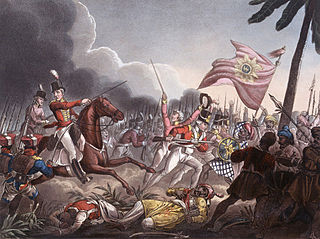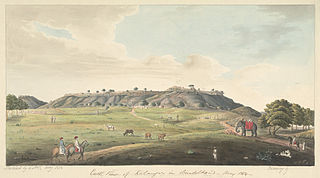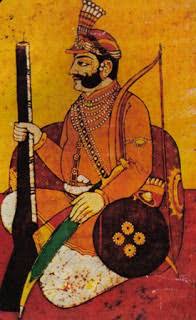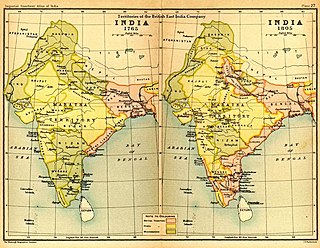
Bajirao I, born as Visaji, was the 7th Peshwa of the Maratha Confederacy.

The Maratha Empire also referred to as the Maratha Confederacy was an early modern Indian empire and later a confederation that controlled large portions of the Indian Subcontinent in the 18th century. Maratha rule formally began in 1674 with the coronation of Shivaji of the Bhonsle dynasty as the Chhatrapati. Although Shivaji came from the Maratha caste, the Maratha empire also included warriors, administrators, and other nobles from the Maratha and several other castes from what is known today as Maharashtra. The Maratha Kingdom was expanded into a full-fledged Empire in the 18th Century under the leadership of Peshwa Bajirao I.

The Second Anglo-Maratha War (1803–1805) was the second conflict between the British East India Company and the Maratha Empire in India. It resulted in major loss of territory for the Marathas, including regions around Delhi and in present-day Gujarat falling into direct Company rule.

Peshwa was second highest office in the Maratha Confederacy, next in rank and prestige only to that of the Chhatrapati. Initially serving as the appointed prime minister in the Maratha empire, the office became hereditary after the death of Shahu in 1749. During the reign of Shahu, the office of Peshwa grew in power and the Peshwas came to be the de facto rulers of the Maratha empire. However following the defeat of the Marathas in 1761, the office of the Peshwa became titular as well and from that point onwards served as the ceremonial head of the Confederacy underneath the Chhatrapati.

Balaji Baji Rao, often referred to as Nana Saheb I, was the 8th Peshwa of the Maratha Confederacy. He was appointed as Peshwa in 1740 upon the death of his father, the Peshwa Bajirao I.

Kalinjar is a fortress-city in Banda district of Uttar Pradesh, in India. It was ruled by several dynasties including the Guptas, the Vardhana dynasty, the Chandelas, Solankis of Rewa, Mughal and the Marathas.

Mastani was the daughter of Chhatrasal and Ruhani Bai Begum. She was the second wife of the Maratha Peshwa Baji Rao I. Her relationship within the Maratha Brahmin family has been subject of both admiration and controversy and well adapted in Indian novels and cinema.

Raghunathrao Bhat, also known as Ragho Ballal or Raghoba Dada, was the younger son of Peshwa Bajirao I who served as the 11th Peshwa of the Maratha Empire for a brief period from 1773 to 1774. He succeeded his Nephew Narayanrao.

Chhatrasal Bundela was the Raja of Panna from 1675 to 1731. He is well known for his Resistance against the Mughal Empire.

Malhar Rao Holkar was a noble subedar of the Maratha Empire, in present-day India. He was one of the early officers along with Ranoji Scindia to help spread the Maratha rule to northern states and was given the estate of Indore to rule by the Peshwas, during the reign of the Maratha emperor Shahu I. He was founder of the Holkar dynasty that ruled Malwa.

The Maratha Conquests were a series of conquests in the Indian subcontinent which led to the building of the Maratha Empire. These conquests were started by Shivaji in 1659, from the victory at the Battle of Pratapgad against Bijapur. The expansion of the empire was limited and interrupted by the Mughal conquests of south India by Mughal ruler Aurangzeb until he eventually died in 1707 in Deccan itself. Marathas were forced to defend their territories against the overwhelmingly strong Mughal army in the 27 years long Deccan wars. They were able to defend their territories and gain an upper hand over Mughals in the sustained conflict.

Jhansi was an independent princely state ruled by the Maratha Newalkar dynasty under suzerainty of British India from 1804 till 1853, when the British authorities took over the state under the terms of the Doctrine of Lapse, and renamed it the Jhansi State. Before the takeover, it was under the Peshwas from 1728 to 1804. The fortified town of Jhansi served as its capital.
Shamsher Bahadur I, was a ruler of the Maratha dominion of Banda in northern India. He was the son of Bajirao I and Mastani.

Nawab Ghazanfar-Jang, Bangash Khan was the first Nawab of Farrukhabad in Uttar Pradesh, India. He was a "Bawan Hazari Sardar" in the Mughal Army. He served as governor of Malwa and Allahabad provinces of the Mughal empire. He was also viceroy of Assam from 1735 to 1743. Although regarded as rude and illiterate, not understanding a single word of Persian or Pashto, he was well regarded for his loyalty, and it is believed that had fortune sided with him he would have been able to establish a kingdom rivalling those in the Deccan or Awadh.

Panna State was a princely state of colonial India, located in modern Panna district of Madhya Pradesh.
The Bhat Peshwa family earlier known as Bhat family is a prominent Indian Chitpavan Brahmin family who dominated India for around 100 years in the late 18th century and early 19th century. Most of the members in this family were the Peshwas in the Peshwa Era of the Maratha Empire, and Peshwa later became their family name. During their regime, most of the Indian subcontinent was under their control. The last Peshwa, Baji Rao II, was defeated by the British East India Company in the Third Anglo-Maratha War in 1818. The territory was annexed to the British East India Company's Bombay Presidency, and he was pensioned.
The Saugor subha was a province of the Maratha Empire comprising the central Indian territories of the Peshwa or prime minister. It was ruled by hereditary Maratha Pandit governors who had their headquarters at the city of Sagar.
The Battle of Palkhed was fought on 28 February 1728 at the village of Palkhed, near the city of Nashik, in what is now Maharashtra, India, between the Maratha Empire and the Nizam-ul-Mulk, Asaf Jah I of Hyderabad wherein the Marathas defeated the Nizam.

The Maratha invasion on Awadh in 1737, led by Peshwa Bajirao and Malhar Rao Holkar, involved campaigns such as Malhar Rao's invasion of Bhadawar, a Rajput vassal of the Mughal Empire, resulting in the Battle of Jalesar. Nawab Saadat Ali Khan of Awadh defeated Malhar Rao at Jalesar, compelling the Marathas to retreat. Subsequently, Bajirao raided Delhi, the Mughal capital, defeating a Mughal contingent at the outskirts but withdrawing upon the approach of Vizier Qamaruddin Khan. During the retreat march, Marathas, including Peshwa wife Mastani, were defeated at a location called Badhsahpur.

The Maratha-Nizam wars (1720–1819) was a series of military conflicts between the Maratha Empire and the Nizam of Hyderabad, spanning nearly a century. These conflicts arose primarily from the Marathas' imposition of Chauth, a form of tribute, on the Nizam's dominions, leading to tensions and subsequent hostilities between the two powers. The Nizam's response to the Maratha demands sparked a series of clashes and wars aimed at resisting Maratha encroachment and asserting territorial sovereignty.














